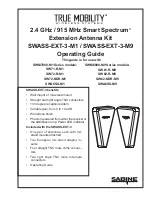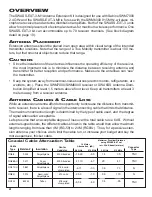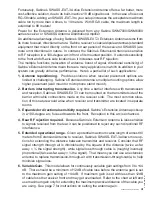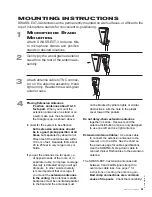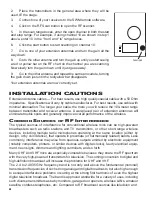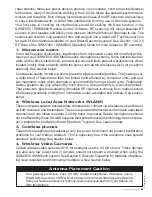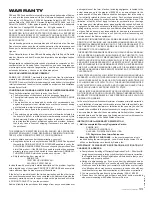
3
LIT-SWASS-EXT-3-OP-080625.indd
©
2008
Sabine,
Inc
Fortunately, Sabine’s SWASS-EXT-3 Active Extension Antenna offers a far better, more
cost-effective solution, due to its built-in active 18 dB signal boost. In the case of low-cost
RG-58 cable, adding an SWASS-EXT-3 to your setup increases the acceptable maximum
cable run by more than 4 times, to 14 meters. With RG-8 cable, the maximum length is
extended to 88 meters!
Power for the Extension Antenna is delivered from any Sabine SWM7000/SWM6000
series receiver or SWA6SS Antenna Distribution Amplifier.
An additional advantage of using Sabine’s SWASS-EXT-3 Extension Antenna stems from
its more focused, directional nature. Sabine receiver’s coaxial dipole antennas (standard
equipment that mount directly on the front or rear panels of the receiver or SWA6SS) are
more omni directional in nature. In contrast, the Sabine’s Extension Antenna is sensitive
to RF reception in a 180-degree arc in front of its mounted position. It extends sensitivity
to the front and off-axis side locations as it increases rear RF rejection.
The multiple functions (relocation of antenna, boost of signal, directional sensitivity) of
Sabine’s Extension Antenna mean there are many applications in which its addition to your
system can greatly enhance performance. Here’s a partial list of such applications:
1. Antenna repositioning.
Provides solutions when receiver placement options are
limited or challenging. Sabine’s Extension Antenna’s multiple mounting options allow
higher placement (wall mount or microphone stand mount).
2. Barriers interrupting transmission.
Any time a barrier interferes with transmission
and reception, Sabine’s SWASS-EXT-3 can be mounted on the transmitter side of the
barrier with cable connections made on the receiver side. The most common situa
-
tion of this nature would arise when receiver and transmitter are located in separate
rooms.
3. Expanded or directional sensitivity required.
Sabine’s Extension Antenna picks up
in a 180-degree arc, focused towards the front. Reception in this arc is enhanced.
4. Rear RF rejection required.
Because Sabine’s Extension Antenna is less sensitive
to signals received from the rear, it can be positioned to reject any such directional RF
interference.
5. Extended operational range.
Given a potential maximum cable length of almost 90
meters from Extension Antenna to receiver, Sabine’s SWASS-EXT-3 allows more op
-
tions for extending the distance between transmitter and receiver. Consider that RF
signal strength through air is diminished by the square of the distance (twice as far
away = ¼ the signal strength), while signal loss through cable is (roughly) inversely
proportional (twice as far away = ½ the signal). That means you can use an extension
antenna to replace transmission-through-air with transmission-through-cable, to help
minimize signal loss.
6. Variable Gain.
This model allows for continuously variable gain settings from 0 to +44
dB. There should be a minimum of 12dB of cable loss before the antenna gain is set
to the maximum gain setting of +44 dB. If maximum gain is set with less than 12dB
of cable loss the receiver front end may get overloaded. Refer to the chart at left and
use maximum gain only for extending the maximum practical distance of the cable you
are using. See page 7 for instructions on setting the antenna gain.
2009
LIT-SWASS-EXT-3-OP-092508.indd

